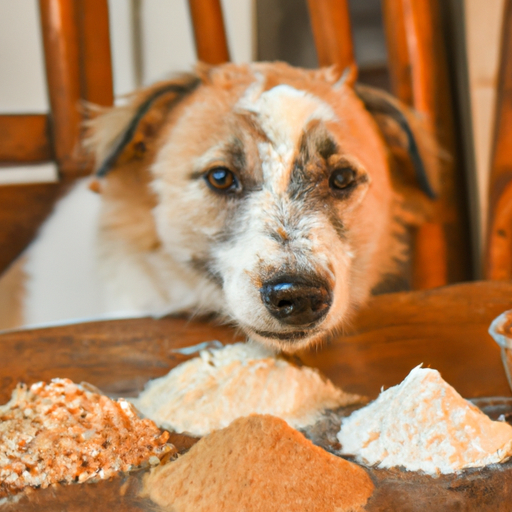What You Need to Know About Dogs and Flour
Let’s start from the beginning. As a careful and mindful caregiver, you’re probably wondering, can dogs eat flour? The answer? It’s not that simple. Many types of flour are safe for dogs, but some can cause health issues.
The primary concern is the dog’s digestive system. Dogs have a harder time digesting complex carbohydrates, which are abundant in many types of flour.
The Safe Types of Flour for Dogs
You’ll be glad to know there are some safe options when it comes to flour. They include:
-
Whole Wheat Flour: Rich in fiber, whole wheat flour is an excellent option. Just be careful if your pooch is gluten intolerant.
-
Brown Rice Flour: A gluten-free alternative, brown rice flour is gentle on your dog’s digestive system and is full of healthy fiber.
-
Oat Flour: Another gluten-free option, oat flour is beneficial for heart health and helps regulate blood sugar levels.
-
Coconut Flour: This flour is high in fiber and healthy fats. It’s also a good option for dogs with digestive issues.
-
Pea Flour: A great source of protein and fiber, pea flour is perfect for dogs with grain allergies.
| Flour Type | Benefits | Drawbacks |
|---|---|---|
| Whole Wheat | Rich in fiber | Not suitable for gluten intolerant dogs |
| Brown Rice | Gluten-free, high in fiber | Can be expensive |
| Oat | Good for heart health, regulates blood sugar | Can cause allergic reactions in some dogs |
| Coconut | High in fiber and healthy fats | Can cause digestive issues if fed in large amounts |
| Pea | High in protein and fiber, grain-free | Can cause gas and bloating |
The Types of Flour to Avoid
Just as there are safe flours, there are those you should avoid. These include:
-
White Flour: Also known as all-purpose flour, white flour can spike your dog’s blood sugar and lead to weight gain.
-
Almond Flour: While almonds themselves are not toxic to dogs, they can cause upset stomach and bloating in dogs.
-
Garbanzo Bean Flour: This flour can cause severe gas and bloating in dogs.
How to Incorporate Flour into Your Dog’s Diet
Now that you know what types of flour are safe, how can you incorporate them into your dog’s diet? The key here is moderation.
You can use these flours to make homemade dog treats. They’re a healthier alternative to store-bought ones, and you can control the ingredients. Remember, treats should make up no more than 10% of your dog’s daily caloric intake.
FAQ
Q: Can dogs eat flour directly?
A: While it’s not toxic, it’s not recommended. Dogs may have difficulty digesting raw flour.
Q: Can I use regular white flour for my dog’s treats?
A: While it’s not toxic, white flour can lead to weight gain and other health issues. It’s best to stick to the safer options.
Q: Are there any symptoms I should watch for if my dog eats the wrong type of flour?
A: Watch for signs of digestive upset, including bloating, gas, diarrhea, and vomiting.
Remember, as a responsible caregiver, your dog’s health is in your hands. Knowing what kind of flour can dogs eat is just one part of maintaining their overall well-being.



